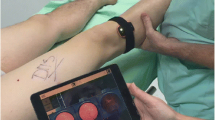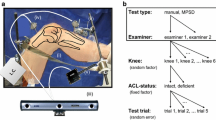Abstract
Purpose
The purpose of the study was to demonstrate the feasibility of a new measurement system using micro-electromechanical systems (MEMS)-based sensors for quantifying the pivot shift phenomenon.
Methods
The pivot shift test was performed on 13 consecutive anterior cruciate ligament-deficient subjects by an experienced examiner while femur and tibia kinematics were recorded using two inertial sensors each composed of an accelerometer, gyroscope and magnetometer. The gravitational component of the acquired data was removed using a novel method for estimating sensor orientations. Correlation between the clinical pivot shift grade and acceleration and velocity parameters was measured using Spearman’s rank correlation coefficients.
Results
The pivot shift phenomenon was best characterized as a drop in femoral acceleration observed at the time of reduction. The correlation between the femoral acceleration drop and the clinical grade was shown to be very strong (r = 0.84, p < 0.0001).
Conclusions
The present study demonstrates the feasibility of quantifying the pivot shift using MEMS-based sensors and removing the gravitational component of acceleration using an estimation of sensor orientation for improved correlation to the clinical grade.







Similar content being viewed by others
References
Ahlden M, Araujo P, Hoshino Y, Samuelsson K, Middleton KK, Nagamune K, Karlsson J, Musahl V (2012) Clinical grading of the pivot shift test correlates best with tibial acceleration. Knee Surg Sports Traumatol Arthrosc 20(4):708–712
Amis A, Cuomo P, Rama R, Giron F, Bull A, Thomas R, Aglietti P (2008) Measurement of knee laxity and pivot-shift kinematics with magnetic sensors. Oper Tech Orthop 18(3):196–203
Araujo PH, Ahlden M, Hoshino Y, Muller B, Moloney G, Fu FH, Musahl V (2012) Comparison of three non-invasive quantitative measurement systems for the pivot shift test. Knee Surg Sports Traumatol Arthrosc 20(4):692–697
Bach BR Jr, Warren RF, Wickiewicz TL (1988) The pivot shift phenomenon: results and description of a modified clinical test for anterior cruciate ligament insufficiency. Am J Sports Med 16(6):571–576
Bull AMJ, Amis AA (1998) The pivot-ship phenomenon: a clinical and biomechanical perspective. Knee 5:141–158
Bull AMJ, Earnshaw PH, Smith A, Katchburian MV, Hassan ANA, Amis AA (2002) Intraoperative measurement of knee kinematics in reconstruction of the anterior cruciate ligament. J Bone Joint Surg Br 84(7):1075–1081
Creamer G (1996) Spacecraft attitude determination using gyros and quaternion measurements. J Astronaut Sci 44(3):357–371
Debandi A, Maeyama A, Hoshino Y, Asai S, Goto B, Smolinski P, Fu FH (2013) The effect of tunnel placement on rotational stability after ACL reconstruction: evaluation with use of triaxial accelerometry in a porcine model. Knee Surg Sports Traumatol Arthrosc 21(3):589–595
Farrell JA (2008) Aided Navigation GPS with High Rate Sensors. McGraw-Hill
Galway HR, MacIntosh DL (1980) The lateral pivot shift: a symptom and sign of anterior cruciate ligament insufficiency. Clin Orthop Relat Res 147:45–50
Grood ES, Suntay WJ (1983) A joint coordinate system for the clinical description of three-dimensional motions: application to the knee. J Biomech Eng 105(2):136–144
Hagemeister N, Parent G, Van de Putte M, St-Onge N, Duval N, de Guise J (2005) A reproducible method for studying three-dimensional knee kinematics. J Biomech 38(9):1926–1931
Hoshino Y, Araujo P, Irrgang JJ, Fu FH, Musahl V (2012) An image analysis method to quantify the lateral pivot shift test. Knee Surg Sports Traumatol Arthrosc 20(4):703–707
Hoshino Y, Kuroda R, Nagamune K, Yagi M, Mizuno K, Yamaguchi M, Muratsu H, Yoshiya S, Kurosaka M (2007) In vivo measurement of the pivot-shift test in the anterior cruciate ligament-deficient knee using an electromagnetic device. Am J Sports Med 35(7):1098–1104
Ishibashi Y, Tsuda E, Yamamoto Y, Tsukada H, Toh S (2009) Navigation evaluation of the pivot-shift phenomenon during double-bundle anterior cruciate ligament reconstruction: is the posterolateral bundle more important? Arthroscopy 25(5):488–495
Jakob RP, Stäubli HU, Deland JT (1987) Grading the pivot shift. Objective tests with implications for treatment. J Bone Joint Surg Br 69(2):294–299
Kocher MS, Steadman JR, Briggs KK, Sterett WI, Hawkins RJ (2004) Relationships between objective assessment of ligament stability and subjective assessment of symptoms and function after anterior cruciate ligament reconstruction. Am J Sports Med 32(3):629–634
Kopf S, Kauert R, Halfpaap J, Jung T, Becker R (2012) A new quantitative method for pivot shift grading. Knee Surg Sports Traumatol Arthrosc 20(4):718–723
Kubo S, Muratsu H, Yoshiya S, Mizuno K, Kurosaka M (2007) Reliability and usefulness of a new in vivo measurement system of the pivot shift. Clin Orthop Relat Res 454:54–58
Labbe DR, de Guise JA, Godbout V, Grimard G, Baillargeon D, Lavigne P, Fernandes J, Masse V, Ranger P, Hagemeister N (2011) Accounting for velocity of the pivot shift test manoeuvre decreases kinematic variability. Knee 18(2):88–93
Labbe DR, de Guise JA, Mezghani N, Godbout V, Grimard G, Baillargeon D, Lavigne P, Fernandes J, Ranger P, Hagemeister N (2010) Feature selection using a principal component analysis of the kinematics of the pivot shift phenomenon. J Biomech 43(16):3080–3084
Labbe DR, de Guise JA, Mezghani N, Godbout V, Grimard G, Baillargeon D, Lavigne P, Fernandes J, Ranger P, Hagemeister N (2011) Objective grading of the pivot shift phenomenon using a support vector machine approach. J Biomech 44(1):1–5
Lane C, Warren R, Stanford F, Kendoff D, Pearle A (2008) In vivo analysis of the pivot shift phenomenon during computer navigated ACL reconstruction. Knee Surg Sports Traumatol Arthrosc 16(5):487–492
Leitze Z, Losee R, Jokl P, Johnson T, Feagin J (2005) Implications of the pivot shift in the ACL-deficient knee. Clin Orthop Relat Res 436:229
Lopomo N, Signorelli C, Bonanzinga T, Marcheggiani Muccioli GM, Visani A, Zaffagnini S (2012) Quantitative assessment of pivot-shift using inertial sensors. Knee Surg Sports Traumatol Arthrosc 20(4):713–717
Maeyama A, Hoshino Y, Debandi A, Kato Y, Saeki K, Asai S, Goto B, Smolinski P, Fu FH (2011) Evaluation of rotational instability in the anterior cruciate ligament deficient knee using triaxial accelerometer: a biomechanical model in porcine knees. Knee Surg Sports Traumatol Arthrosc 19(8):1233–1238
Noyes FR, Grood ES, Cummings JF, Wroble RR (1991) An analysis of the pivot shift phenomenon. The knee motions and subluxations induced by different examiners. Am J Sports Med 19(2):148–155
Okazaki K, Tashiro Y, Izawa T, Matsuda S, Iwamoto Y (2012) Rotatory laxity evaluation of the knee using modified Slocum’s test in open magnetic resonance imaging. Knee Surg Sports Traumatol Arthrosc 20(4):679–685
Petermann J, Trus P, Niess C, Gotzen L (1999) A modified pivot-shift test for diagnosis confirmation in anterior cruciate ligament rupture. Knee 6(2):131–136
Petrie A (2006) Statistics in orthopaedic papers. J Bone Joint Surg Br 88(9):1121–1136
Roetenberg D, Luinge HJ, Baten CT, Veltink PH (2005) Compensation of magnetic disturbances improves inertial and magnetic sensing of human body segment orientation. IEEE Trans Neural Syst Rehabil Eng 13(3):395–405
Windolf M, Gotzen N, Morlock M (2008) Systematic accuracy and precision analysis of video motion capturing systems–exemplified on the Vicon-460 system. J Biomech 41(12):2776–2780
Zaffagnini S, Lopomo N, Signorelli C, Marcheggiani Muccioli GM, Bonanzinga T, Grassi A, Visani A, Marcacci M (2013) Innovative technology for knee laxity evaluation: clinical applicability and reliability of inertial sensors for quantitative analysis of the pivot-shift test. Clin Sports Med 32(1):61–70
Zaffagnini S, Signorelli C, Lopomo N, Bonanzinga T, Marcheggiani Muccioli GM, Bignozzi S, Visani A, Marcacci M (2012) Anatomic double-bundle and over-the-top single-bundle with additional extra-articular tenodesis: an in vivo quantitative assessment of knee laxity in two different ACL reconstructions. Knee Surg Sports Traumatol Arthrosc 20(1):153–159
Acknowledgments
The authors would like to thank the Canada Research Chair in 3D Imaging and Biomedical Engineering, Prompt Inc., and Emovi Inc. for funding. We would also like to thank Gerard Parent for his invaluable help in operating the Vicon optical reference system during the validation process.
Conflict of interest
The authors declare that they have no conflict of interest.
Author information
Authors and Affiliations
Corresponding author
Electronic supplementary material
Below is the link to the electronic supplementary material.
Rights and permissions
About this article
Cite this article
Labbé, D.R., Li, D., Grimard, G. et al. Quantitative pivot shift assessment using combined inertial and magnetic sensing. Knee Surg Sports Traumatol Arthrosc 23, 2330–2338 (2015). https://doi.org/10.1007/s00167-014-3056-8
Received:
Accepted:
Published:
Issue Date:
DOI: https://doi.org/10.1007/s00167-014-3056-8




